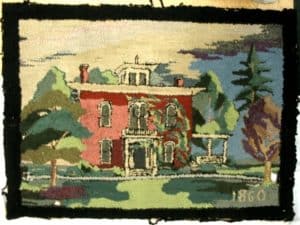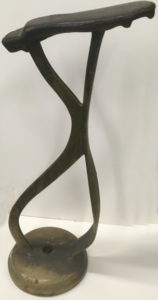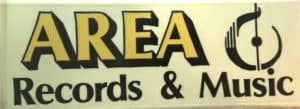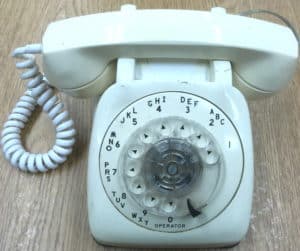A New Year’s Wish for More Artifacts
By John Marks, Curator of Collections and Exhibits
Last month I outlined our photograph collection and talked about subjects and time periods we would like to add. This month, I’ll be discussing artifacts, also known as objects or just “stuff.”
Although established in 1883, the Geneva Historical Society has only been collecting things since the 1940s. Originally, membership was limited to Geneva-born white males over 40 years old. (There are no requirements anymore, please join us!) Members met to read and discuss papers about local history, but not very often. Over the first seven decades, the Historical Society went through cycles of activity and dormancy.
In the 1940s the Historical Society began collecting and displaying artifacts in a series of temporary homes. Beverly Chew’s donation of 543 South Main Street as a permanent museum in 1960 meant the Historical Society could collect without fear of relocation.
There is a public perception of what “belongs” in a museum. One factor may be condition. Antiques shows on television throw around the term “museum quality” for things that are old and in perfect condition. The same shows focus on monetary value. On a personal level, people want to donate things that have been in their family but are no longer wanted by a younger generation. There is also the notion that recent things – used within one’s lifetime – don’t belong in a museum.
Addressing these perceptions is part of my job. Our mission states that we “collect…artifacts which provide a visual and tangible connection to Geneva’s past.” That can include things made in Geneva and/or by Genevans; used or owned by local residents; or having a direct and important connection to an institution, event, or person in Geneva. The story about the object, or provenance, is an important factor for us.
 So what does this mean? Without listing everything in our collection, here are some examples. We’re interested in arts and crafts created by Genevans or showing local scenes. Emma Herendeen liked to hook rugs of local buildings and scenes. She made a hook rug of the house at 546 Castle Street with “1860”, the year it was built, in the corner. We have quite a bit of archival information on Emma, and her rugs are another facet of her life.
So what does this mean? Without listing everything in our collection, here are some examples. We’re interested in arts and crafts created by Genevans or showing local scenes. Emma Herendeen liked to hook rugs of local buildings and scenes. She made a hook rug of the house at 546 Castle Street with “1860”, the year it was built, in the corner. We have quite a bit of archival information on Emma, and her rugs are another facet of her life.

 We have work-related objects, such as carpentry hand tools, and machinists’ tool kits from American Can Company. The images above and to the right represent small businesses. Tony’s Barber Shop was owned by Anthony Martino; we have his work shirts and other things from his shop as well. The shoe stand came from Joseph George’s Shoe Shine and Hat Cleaning Parlor. In the 20th century, services like barbering and shoe shining were ways for Italian Americans (Mr. Martino) and Syrian Americans (Mr. George) to own businesses.
We have work-related objects, such as carpentry hand tools, and machinists’ tool kits from American Can Company. The images above and to the right represent small businesses. Tony’s Barber Shop was owned by Anthony Martino; we have his work shirts and other things from his shop as well. The shoe stand came from Joseph George’s Shoe Shine and Hat Cleaning Parlor. In the 20th century, services like barbering and shoe shining were ways for Italian Americans (Mr. Martino) and Syrian Americans (Mr. George) to own businesses.
 We document local businesses with a variety of objects. They can be as small as matchbook covers and pens, or as large as the plastic sign that hung over the sidewalk at Area Records on Seneca Street.
We document local businesses with a variety of objects. They can be as small as matchbook covers and pens, or as large as the plastic sign that hung over the sidewalk at Area Records on Seneca Street.
 We rely on the public to tell us when they see change happening. A member of the Geneva Fire Department told us that the old neighborhood alarm pull boxes were being discontinued and removed. We said we’d like one for the collection and he made sure we got one. We probably wouldn’t have noticed this change to the city streetscape until it was too late to save a box.
We rely on the public to tell us when they see change happening. A member of the Geneva Fire Department told us that the old neighborhood alarm pull boxes were being discontinued and removed. We said we’d like one for the collection and he made sure we got one. We probably wouldn’t have noticed this change to the city streetscape until it was too late to save a box.
Like with photographs, one challenge is getting donors to think of the things they grew up with as historical. For folks over the age of 50, a rotary phone was THE phone when we grew up. Most school children have never seen a phone like this, let alone dialed one.

We have two rotary dial desk phones, like the one on the left, but we don’t have a pay phone in our collection. Once common, phone companies removed them as more people used cell phones. Do you have one to donate? Rotary dial would be nice but we can’t be choosey.
These are just a few examples of artifacts that tell Geneva’s stories. If you would like to donate but are unsure if we would want something, please give us a call.
